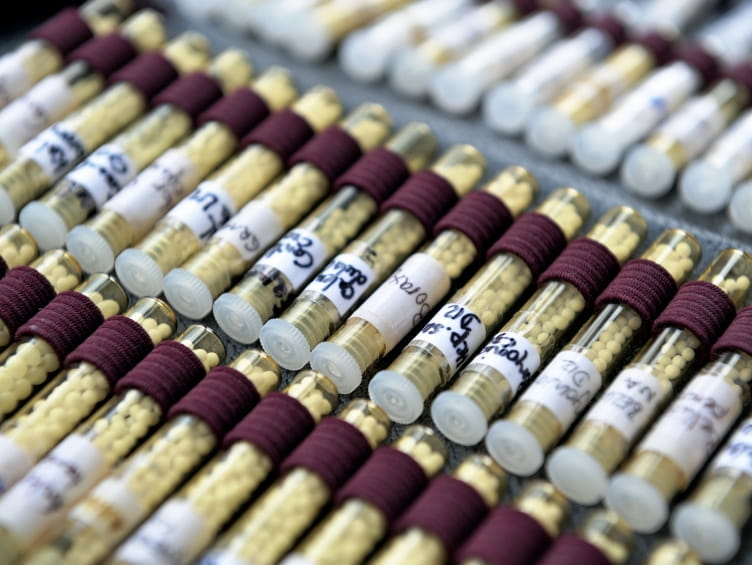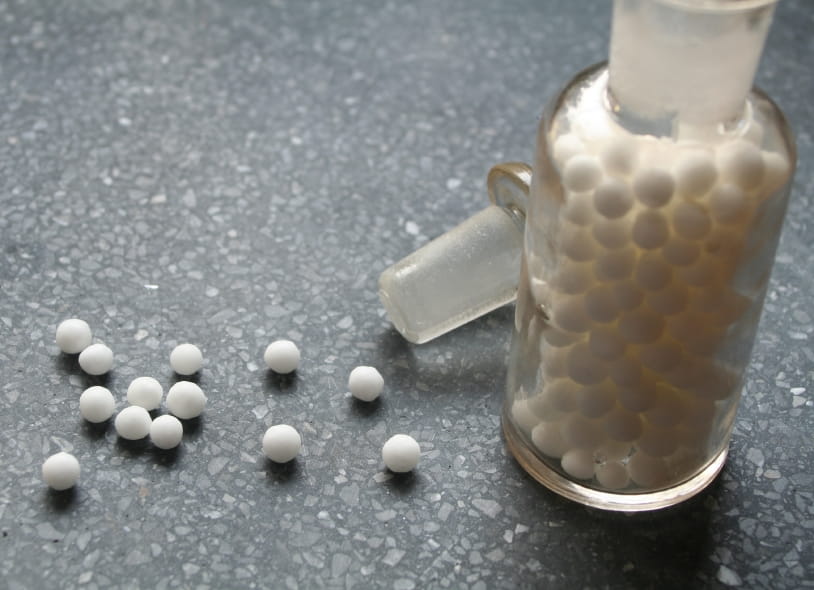Homeopathic Medications for Children Know the Risks and Proper Usage

The Bottom Line
Most homeopathic medications are not poisonous IF they are diluted correctly and don't contain alcohol. Some homeopathic products have caused toxicity, adverse reactions, and allergic reactions. Others don't contain any active ingredients and may not be appropriate treatment for a condition. FDA does not evaluate homeopathic products for efficacy and safety.

The Full Story
Some parents turn to homeopathic therapies because they worry about giving medicine to their children. Up to 10 percent of children are given homeopathic remedies, especially for ear, nose and throat problems (ear infections, teething pain) and for respiratory conditions.
At one time, homeopathic therapies were prescribed for individual patients by homeopathic practitioners. Now, some homeopathic products are widely available in stores. People are self-prescribing - or choosing products for their children. Parents call Poison Control with questions about how these products work and if they are safe.
What is homeopathy?
Homeopathy is a type of medical practice that was established in the 18th century. It proposes that ailments can be cured by taking small amounts of products that, in large amounts, would cause the very symptom you are treating. In fact, the word homeopathy comes from the Greek words: homoios = like, and pathos = suffering. For example:
- If your child was teething and was agitated, a homeopathic treatment may be a very dilute amount of a plant such as belladonna, a plant known to cause agitation.
- If the child had a phlegmy cough, a homeopathic treatment could be aconitum, a plant that is known to cause increased secretions.
- Shingles, hives, or fever blisters might be treated with an extract of poison ivy.
- Nux vomica (strychnine) might be given for a runny nose, sneezing, and a cough.
Homeopathic treatments are based on products from nature: plants, animals, or minerals. Homeopathic preparations may be tablets, pills, liquids, drops, or ointments and gels.
In homeopathic preparations, the active ingredient is so diluted that the final product contains little if any of that active ingredient. On the back of a homeopathic preparation, active ingredients are not listed in milligrams. Instead, they are listed as a number and letter, such as 24X, 60X, or 400X. These indicate ratios of active ingredients to other ingredients.
An example: in a liquid preparation with a 6X ingredient, there is 0.000001 milliliter of active ingredient for every one milliliter of diluent solution. The higher the number, followed by X, the more dilute the ingredient. 24X is approximately the point where no molecules of active ingredient are present.
Homeopathic practitioners believe that their remedies work to treat ailments. Homeopathic practitioners believe that the active ingredient, even if no longer present, leaves a "memory" in the fluid used to dilute it. They believe that this fluid also has medicinal properties.
Are homeopathic preparations effective?
Standard medical literature finds little if any evidence that homeopathy works at all. Non-homeopathic health practitioners generally believe that if a product is so dilute that it contains no active ingredient, it can have no effect except as a placebo (sugar pill).
Are homeopathic preparations safe?
The FDA does regulate the homeopathic industry; homeopathic products must meet certain standards established by homeopathic practitioners. But FDA does not evaluate the safety or effectiveness of homeopathic products. This means that a product can be sold with a label stating that it is effective for treating a condition, even though there is no proof that it is effective or safe.
Some of the products contained in homeopathic medications could be quite dangerous if you encountered them in nature. The belladonna, aconitum, poison ivy, and strychnine mentioned above can be toxic. Other potentially dangerous ingredients include other poisonous plants, crushed bees, and arsenic and other heavy metals. However, in practice, homeopathy dilutes the product so much that there may be no active ingredients at all in the final product.
Because of this large dilution, widely available homeopathic brands are generally considered non-toxic. This is true for teething remedies, for example, even if a large amount is swallowed at once.
However, there have been reports of homeopathic preparations causing adverse effects.
- The products may not have been diluted properly, causing toxicity. A number of people lost their sense of smell after using a cold remedy containing zinc.
- The patient may have been highly allergic to the active ingredient.
- The patient may have had a reaction to the ingredients used to manufacture the product.
- Heavy metals may have been used. These should never be consumed by a child or anyone else, in any dilution.
- Some homeopathic products for children use honey to dilute the active ingredient. Honey should never be given to children under 12 months old.
- Some homeopathic medications are diluted in alcohol and are not suitable for children.
In any case, consult a health care professional for help treating an illness. Giving homeopathic preparations could cause a delay in treating a serious condition. Consult your child's pediatrician about safe remedies for illness or discomfort.
If you are using a homeopathic medication and have questions, call Poison Control at 1-800-222-1222, or use the use the webPOISONCONTROL® online tool for guidance if too much was swallowed.
Pela Soto, BS, BSHS, PharmD
Certified Specialist in Poison Information
Poisoned?
Call 1-800-222-1222 or
Prevention Tips
- Keep all medications away from children. This includes homeopathic medications which are often considered nontoxic.
- Some homeopathic products may contain honey, which is not safe for children under one year old.
- Some homeopathic preparations are diluted in alcohol and are not suitable for children.
This Really Happened
Case 1: A worried mother called Poison Control because her 3-year-old child swallowed an unknown amount of homeopathic cough medicine. The poison specialist that handled the call advised the child to be watched at home. The mother was instructed to call back if the child developed any symptoms, such as drowsiness. When Poison Control called the mother the next day to follow-up, the she reported the child had not developed any symptoms.
Case 2: Parents gave their 21-day-old child the recommended dose of a homeopathic preparation to treat colic. The child stopped breathing, turned blue, and became stiff. The child was admitted to the intensive care unit. The child remained in the hospital for three days, during which time numerous studies were carried out to rule out other causes for the life-threatening symptoms. The product label listed several active and inactive ingredients; three of the active ingredients have been shown to cause toxic effects. Laboratory studies were conducted of two bottles of the same product; ingredients NOT found on the label were identified, including alcohols.
Reference: Aviner S, Berkovitch M, Dalkian H, Braunstein R, Lomnicky Y, Schlesinger M. Use of a homeopathic preparation for “infantile colic” and an apparent life-threatening event. Pediatrics 2010;125;pp. e318-e323; originally published online January 25, 2010; DOI: 10.1542/peds.2008-3515.
For More Information
US Department of Health & Human Services; National Institutes of Health; National Center for Complementary and Alternative Medicine. Homeopathy: An Introduction [Internet]. Bethesda (MD): NCCAM. 2009 July [Updated 2013 May; cited 2014 Feb].References
Poisoned?
Call 1-800-222-1222 or
Prevention Tips
- Keep all medications away from children. This includes homeopathic medications which are often considered nontoxic.
- Some homeopathic products may contain honey, which is not safe for children under one year old.
- Some homeopathic preparations are diluted in alcohol and are not suitable for children.
This Really Happened
Case 1: A worried mother called Poison Control because her 3-year-old child swallowed an unknown amount of homeopathic cough medicine. The poison specialist that handled the call advised the child to be watched at home. The mother was instructed to call back if the child developed any symptoms, such as drowsiness. When Poison Control called the mother the next day to follow-up, the she reported the child had not developed any symptoms.
Case 2: Parents gave their 21-day-old child the recommended dose of a homeopathic preparation to treat colic. The child stopped breathing, turned blue, and became stiff. The child was admitted to the intensive care unit. The child remained in the hospital for three days, during which time numerous studies were carried out to rule out other causes for the life-threatening symptoms. The product label listed several active and inactive ingredients; three of the active ingredients have been shown to cause toxic effects. Laboratory studies were conducted of two bottles of the same product; ingredients NOT found on the label were identified, including alcohols.
Reference: Aviner S, Berkovitch M, Dalkian H, Braunstein R, Lomnicky Y, Schlesinger M. Use of a homeopathic preparation for “infantile colic” and an apparent life-threatening event. Pediatrics 2010;125;pp. e318-e323; originally published online January 25, 2010; DOI: 10.1542/peds.2008-3515.
